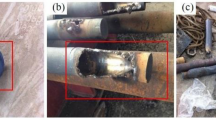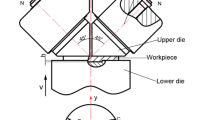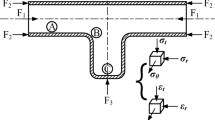Abstract
Deformation allocation is an important factor that affects 720° curling forming from copper-coated steel strips to double-walled brazed tubes (DWBTs). In this study, four schemes of deformation allocation, considering different weights of the total feed distance, are proposed, and a 3D finite element (FE) model of the multi-pass roll forming process for DWBT is developed and verified to investigate the cross-sectional evolution and deformation features. The results show the following. (i) In the 720° curling forming process from the steel strip into double-walled tubes, the curvature of the formed circular arc initially increases and then remains stable with roll forming, and the inner and outer tubes of the DWBT are formed in the third and fifth forming passes. Size forming can eliminate the gap between the double walls and improve the overall roundness. (ii) For different deformation allocations, the cross-sectional profiles of the roll-formed parts exhibit a discrepancy, and the deformation amount varies with the roll-forming process. The deformation amount in Scheme three is the maximum, and the cross-sectional profile deviates significantly from the ideal shape and fails to form a DWBT, which indicates that the deformation allocation is unsuitable. (iii) The roundness of the outer tube is better than that of the inner tube. Therefore, the roundness of the inner tube is the key to restricting the forming accuracy of the DWBT. Compared with Schemes one and two, Scheme four with a linear allocation of the total feed distance exhibits the best roundness, and the deformation allocation is reasonable; i.e., when the contact points between the rollers and steel strip are in a straight line, the roundness of the DWBT is in good agreement with the ideal condition.




















Similar content being viewed by others
References
Zhang WD, Zhao GQ, Fu QJ (2019) Optimization of roll forming process for high-strength V channel steels. Int J Adv Manuf Tech 105(2):2469–2480
Moneke M, Groche P (2021) Control of residual stresses in roll forming through targeted adaptation of the roll gap. J Mater Process Technol 294(3):117129. https://doi.org/10.1016/j.jmatprotec.2021.117129
Paralikas J, Salonitis K, Chryssolouris G (2010) Optimization of roll forming process parameters—a semi-empirical approach. Int J Adv Manuf Tech 47(9/12):1041–1052
Liu XL, Cao JG, Chai XT et al (2017) Investigation of forming parameters on springback for ultra high strength steel considering Young’s modulus variation in cold roll forming. J Manuf Process 29:289–297
Liu XL, Cao JG, Chai XT et al (2018) Experimental and numerical prediction of the local thickness reduction defect of complex cross-sectional steel in cold roll forming. Int J Adv Manuf Tech 95:1837–1848
Su CJ, Liu JZ, Zhao ZX et al (2020) Research on roll forming process and springback based on five-boundary condition forming angle distribution function. J Mech Sci Technol 34(9/12):5193–5204
Safdarian R, Naeini HM (2015) The effects of forming parameters on the cold roll forming of channel section. Thin-Walled Struct 92:130–136
Poursafar A, Saberi S, Tarkesh R et al (2022) Experimental and mathematical analysis on spring-back and bowing defects in cold roll forming process. Int J Interact Des Manuf 16(2):531–543
Yaser T, Hassan MN, Roohollah AT et al (2018) A strategy to reduce the twist defect in roll-formed asymmetrical-channel sections. Thin-Walled Struct 130:395–404
Sheu JJ, Yu CH, Wang JK (2017) Die designs of cold roll forming process for car bumper using advanced high strength steel. Procedia Eng 207:1308–1313
Fan LF, Yan JX, Gao Y et al (2016) Research on deformation characteristics of JCOE forming in large diameter welding pipe. Adv Manuf 4(3):268–277
Luo JT, Xue YH, Chen K et al (2017) Integrated simulation and experimental test of the residual stress field for large-sized straight welded pipe processed with JCOE technology. Int J Steel Struct 17(1):265–272
Ren Q, Zou TX, Li DY et al (2015) Numerical study on the X80 UOE pipe forming process. J Mater Process Technol 215:264–277
Zou TX, Wu GH, Li DY et al (2015) A numerical method for predicting O-forming gap in UOE pipe manufacturing. Int J Mech Sci 98:39–58
Zou TX, Li DY, Wu GH et al (2016) Yield strength development from high strength steel plate to UOE pipe. Mater Design 89:1107–1122
Yu JX, Han MX, Yu Y et al (2021) The research on pipe structural behavior of 3D UOE manufacturing process. Thin-Walled Struct 158:107168. https://doi.org/10.1016/j.tws.2020.107168
Chen WY, Jiang JM, Li DY et al (2019) Flower pattern and roll positioning design for the cage roll forming process of ERW pipes. J Mater Process Technol 264:295–312
Cheng JJ, Cao JG, Zhao JW et al (2020) The flower pattern and rolls design for ERW pipes with the different specification in the flexible roll forming process. Thin-Walled Struct 154:106809. https://doi.org/10.1016/j.tws.2020.106809
Qiu LM, Zhang SY, Wang ZL et al (2019) A robust optimization design method for sheet metal roll forming and its application in roll forming circular cross-section pipe. Int J Adv Manuf Tech 103(11):2903–2916
Mahendra K, Hardik K (2015) Geometric specification of bevel wrap** of double walled tubes, prediction of failure from material properties. Int J Res Eng Tech 4(7):1–6
Acknowledgements
The authors thank the National Natural Science Foundation of China (Grant No. 52275379).
Author information
Authors and Affiliations
Corresponding author
Rights and permissions
Springer Nature or its licensor (e.g. a society or other partner) holds exclusive rights to this article under a publishing agreement with the author(s) or other rightsholder(s); author self-archiving of the accepted manuscript version of this article is solely governed by the terms of such publishing agreement and applicable law.
About this article
Cite this article
Liu, MM., Liu, YL. & Li, H. Insight into deformation allocation in the multi-pass roll forming of a double-walled brazed tube. Adv. Manuf. 11, 567–586 (2023). https://doi.org/10.1007/s40436-023-00448-y
Received:
Revised:
Accepted:
Published:
Issue Date:
DOI: https://doi.org/10.1007/s40436-023-00448-y




